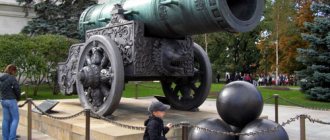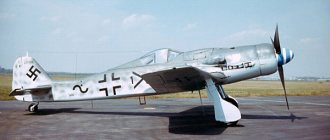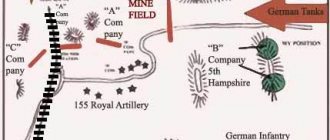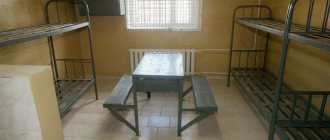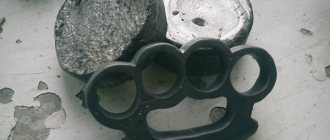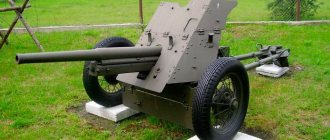Home » Literature on the history of artillery » What made the German 88-mm Akht-Akht gun so famous
Literature on the history of artillery
boroda 04/17/2020 2825
5
in Favoritesin Favoritesfrom Favorites 0
During World War II, the Germans had quite a lot of 88 mm cannons. The FlaK gun became the basis for almost all known examples of such effective weapons.
. It was created in 1918 with subsequent modernizations in 36, 37, 41 and 43.
"Eight-eight"
The FlaK 18/36/37 anti-aircraft gun became the most famous. He was nicknamed "eight-eight"
according to caliber.
In fact, it was an anti-aircraft gun with which the Germans effectively fought enemy tanks. She was excellent at shooting down bombers, and at times she made holes in tanks.
FlaK41
At a distance of about 1.5 km, this gun could easily penetrate armor about 100 mm thick.
At a large approach, for example, about 100 meters, the FlaK version from 1941 was capable of penetrating 194 mm armor
.
Use of captured German 88 mm anti-aircraft guns
German 88-mm cannons, also known as “Acht-Komma-Acht Zentimeter” (eight, eight centimeters), became as symbolic of German weapons of World War II as the Ju 87 bomber or the Pz.Kpfw.VI Tiger Ausf.E tank.
88-mm anti-aircraft guns were used not only against aircraft; in the absence of specialized anti-tank guns, they were successfully used to combat well-protected medium and heavy tanks, as well as in coastal defense.
After Germany's defeat in World War I, it was prohibited from owning or creating anti-aircraft artillery, and already built anti-aircraft guns were subject to destruction. In this regard, work on the design and implementation of new anti-aircraft guns in metal was carried out in Germany secretly or through front companies in other countries. For the same reason, all anti-aircraft guns designed in Germany before 1933 were designated “mod. 18". Thus, in case of requests from representatives of England and France, the Germans could answer that these were not new guns, but old ones, created during the First World War.
In the second half of the 1920s, when designing anti-aircraft guns in Germany designed to counter high-altitude (by the standards of those years) air targets, the 75-mm caliber was initially considered. Work on such artillery systems was carried out by Rheinmetall-Borsig AG and Friedrich Krupp AG.
At the end of the 1920s, Rheinmetall-Borsig AG created several experimental 75-mm guns with barrel lengths of 55 and 59 calibers. However, these anti-aircraft guns were not adopted by the Reichswehr. As part of military cooperation, a gun known as the 7.5 cm Flak L/59 was offered to the USSR.
The original samples, manufactured in Germany, were tested at the Anti-Aircraft Research Site in February-April 1932. In the same year, this gun, converted to a 76.2-mm caliber, was put into service in the USSR under the designation “76-mm anti-aircraft gun mod. 1931" (3-K).
76-mm anti-aircraft gun mod.
1931 Anti-aircraft gun "mod.
1931" was a completely modern weapon with good ballistic characteristics for that time. Its carriage with four folding frames provided all-round fire; with a projectile weight of 6.5 kg, the height reach was 9 km. Rate of fire – 15 rounds/min. Weight in combat position - 3750 kg, in stowed position - 4970 kg. In 1930, designers from Friedrich Krupp AG, working in Sweden, in agreement with Bofors, created the 7.5 cm Flak L/60 anti-aircraft gun. In Sweden, the gun was mass-produced under the designation Bofors 75 mm Model 1929.
75 mm anti-aircraft gun 7.5 cm Flak L/60
This 75-mm gun with a semi-automatic bolt and a cross-shaped platform was not officially accepted into service in Germany, but was actively produced for export. In 1939, unsold samples were requisitioned by the German Navy and used in anti-aircraft coastal defense units. The Germans captured several dozen of these guns in Norway.
88 mm anti-aircraft guns 8.8 cm Flak 18/36/37/41
In 1928, designers from Friedrich Krupp AG, working in Sweden, began creating an 88-mm anti-aircraft gun. When designing the new gun, the developments obtained during the creation of the 7.5 cm Flak L/60 were used. Later, the design documentation was secretly delivered to Essen. And already in Germany the first prototypes were made. The prototype was tested back in 1931, but mass serial production of 88 mm guns began after Hitler came to power.
88 mm anti-aircraft guns 8.8 cm Flak 18 in transport position
For its time, it was a very advanced weapon, which is recognized as one of the best German artillery systems of the Second World War. The 88-mm anti-aircraft gun had very high characteristics for that time. A fragmentation projectile weighing 9 kg could hit targets at altitudes of up to 10,600 m.
88-mm anti-aircraft gun in a firing position with crew
The maximum firing range at air targets was 14,800 m. The weight of the gun in firing position was 5,000 kg. Rate of fire – up to 20 rounds/min. Calculation – 10 people. For transportation, two single-axle trolleys were used. Towing was most often carried out by the Sd.Kfz half-track tractor. 7.
North Africa, German 88-mm anti-aircraft gun towed by an Sd.Kfz tractor. 7
The baptism of fire of the 8.8 cm Flak 18 took place in 1937 in Spain. Since there were few air targets worthy of attention, the main purpose of the 88-mm anti-aircraft guns was to fire at ground targets. Five batteries of anti-aircraft artillery were concentrated in the vicinity of Burgos and Santander. During the Republican offensive at Terual, two batteries were used to defend Burgos, Almazana and Zaragoza.
In March 1938, two batteries of German 88-mm guns supported the actions of the Francoists in the Villaneva de Heva area. At the same time, anti-aircraft guns were used with great success for counter-battery combat against Republican artillery. In the fall of 1938, Flak 18 made a very significant contribution to the defeat of the Republican forces during the Battle of the Ebro. 88-mm anti-aircraft guns, placed on direct fire, destroyed firing points with high accuracy. At the end of hostilities, the Condor Legion had 52 Flak 18 guns.
The combat experience gained in Spain was subsequently taken into account when creating modernized models of 88-mm anti-aircraft guns. The most noticeable external innovation was the shrapnel protection shield introduced on parts of the guns. In order to reduce production costs, brass parts were replaced with stainless steel ones.
For the 8.8 cm Flak 18, two different trolleys were used (with single and double wheels). And for the purpose of unification, a single gable trolley was introduced on the modernized 8.8 cm Flak 36 gun, which also made it easier to transport the anti-aircraft gun on soft soils. The introduction of a single transport trolley led to changes in the design of the gun. It was necessary to unify the front and rear parts of the carriage. It was impossible to ensure the interchangeability of the carts in any other way.
Transfer of 8.8 cm Flak 36 into firing position, transport carts are already separated from the carriage
But the main modernization affected the gun barrel, which received a detachable front part. At the same time, the ballistic characteristics of the gun and the rate of fire did not change.
88-mm anti-aircraft gun 8.8 cm Flak 36 in a firing position with crew
In 1939, production of the 8.8 cm Flak 37 anti-aircraft gun began. Externally, this model was almost no different from the 8.8 cm Flak 36. The modernization of the gun in this case affected not the mechanical part, but the gun guidance system.
The Flak 37 guns were equipped with an Ubertransunger 37 automatic aiming system based on data transmitted via cable from the fire control equipment of the anti-aircraft battery. 88-mm anti-aircraft guns of this modification were the first to be able to interface with the FuMG 62 Wurtzberg 39 fire control radar.
Anti-aircraft fire control radar FuMG 62 Wurtzberg 39
A radar with a parabolic antenna with a diameter of 3 meters, a wavelength of 53 cm and a pulse power of up to 11 kW could correct anti-aircraft artillery fire at a range of up to 29 km. At a distance of 10 km, the error when tracking an air target was 30–40 meters. The radar screen displayed not only air targets, but also explosions of anti-aircraft shells.
Due to the fact that in the late 1930s the emergence of high-altitude reconnaissance and bombers was predicted, operating at altitudes inaccessible to existing anti-aircraft guns, Rheinmetall-Borsig AG began work on an 88-mm gun with increased range and height reach.
In 1941, a new 8.8 cm Flak 41 anti-aircraft gun, adapted for firing ammunition with a reinforced propellant charge, arrived for testing. A projectile weighing 9.4 kg left a two-section barrel with a length of 72 calibers (originally a three-section 74 caliber) with an initial speed of 1000 m/s. At the same time, the projectile could rise to a height of 14800 m. Thanks to the improved loading system, the rate of fire increased from 20 to 25 rounds/min.
8.8 cm Flak 41 in firing position
To control the fire, the Kommandogerät 40 device was used, which was an optical rangefinder interfaced with an analog mechanical computer.
Kommandogerät 40 on display at the museum
The Kommandogerät 40 device, operated by a team of five people, made it possible to accurately determine the flight parameters of an air target and semi-automatically transmit data via wire to all four guns of the anti-aircraft battery. This facilitated and significantly accelerated the process of aiming anti-aircraft guns, which ultimately increased the firing efficiency.
During the war years, modified Kommandogerät 40 devices were also used to control the fire of other modifications of 88-mm anti-aircraft guns.
The 8.8 cm Flak 41 had the best characteristics in the family of German 88 mm anti-aircraft guns. But this weapon was quite expensive and difficult to manufacture. Before the surrender of Germany, only 556 units were produced. At the same time, 20,754 units of 8.8 cm Flak 18/36/37 guns were produced.
In 1942, they tried to cross the Flak 41 barrel with the Flak 37 carriage. Tests of the “hybrid” were unsuccessful; the design could not withstand the increased load. Satisfactory results were achieved after strengthening a number of parts and introducing a muzzle brake.
Mass production was impossible due to overload with other orders. A total of 13 guns, known as 8.8 cm Flak 37/41, were produced. An attempt to produce a gun with a Flak 41 barrel on the carriage of a 105 mm 10.5 cm FlaK 39 anti-aircraft gun also failed.
In the initial period of World War II, 88-mm anti-aircraft guns played a leading role in providing air defense to the territory of the Third Reich. As of September 1, 1939, the Luftwaffe anti-aircraft units had 2,628 heavy anti-aircraft guns, the vast majority of which were 8.8 cm Flak 18/36/37. In Great Britain at that time there were approximately half as many anti-aircraft guns, which could be compared in range and reach with the German “acht-acht”.
But even after 105 and 128 mm anti-aircraft guns were created and entered service in Germany, 88 mm guns still made up the majority. In June 1944, there were more than 10,000 of these guns in the German armed forces. 88-mm anti-aircraft guns were used by anti-aircraft battalions of tank and infantry divisions, but even more often these guns were used in anti-aircraft units of the Luftwaffe.
88 mm anti-aircraft guns were also used in the role of universal artillery in coastal defense. The guns installed on the coast were the first to open fire on enemy bombers flying from the sea. They also repeatedly had the opportunity to engage in battle with the enemy fleet.
Thus, during Operation Agreement, carried out by the British on September 13–14, 1942, with the aim of disrupting the communications of the Axis countries in North Africa, in the vicinity of Tobruk, the fire of a battery of 88-mm anti-aircraft guns deployed on the shore was heavily damaged and subsequently sank the destroyer HMS Sikh (F82).
Of all the German anti-aircraft guns, the "acht-acht" played the most prominent role in anti-tank defense. Often, German heavy anti-aircraft guns were brought in to suppress enemy artillery batteries and provide fire support to ground troops.
In 1939, during the Polish campaign, heavy anti-aircraft batteries armed with Flak 18/36 cannons were used very little for their intended purpose. The 20-mm and 37-mm MZA calibers coped well with Polish aircraft flying at low altitudes, providing effective protection for their troops. During the entire campaign in Poland, heavy anti-aircraft batteries fired at Polish aircraft only a few times, but they were widely used to destroy ground targets.
During the fighting on French territory, 88-mm anti-aircraft guns were very effective against French Char B1 bis heavy tanks and British Matilda Mk I infantry tanks.
The Flak 18/36 guns became a real lifesaver for the Germans, effective both in air defense and against ground targets. During the 1940 campaign in the West, artillerymen of the 1st Anti-Aircraft Corps destroyed on the ground: 47 tanks and 30 pillboxes. The 2nd Anti-Aircraft Corps, supporting the actions of the 4th and 6th armies, knocked out 284 tanks and destroyed 17 bunkers.
During the African Campaign, the 88 mm anti-aircraft guns available in the German Afrika Korps proved to be a deadly anti-tank weapon, largely devaluing the British superiority in the number and quality of tanks.
Rommel's troops that arrived in Africa initially had only 37 mm 3.7 cm Pak 35/36 anti-tank guns, Pz.Kpfw tanks. II with 20 mm cannon, Pz.Kpfw. III with a 37 mm cannon and Pz.Kpfw. IV with a 75 mm short-barreled gun. The British had well-armored tanks Mk.VI Crusader, Matilda Mk.II, Valentine Mk.III, which were low-vulnerable to German tank and anti-tank guns. Therefore, 88-mm anti-aircraft guns turned out to be the only effective means of combating enemy tanks for German troops.
Apart from corps artillery, in the summer of 1941, 88mm anti-aircraft guns were the only German artillery systems capable of penetrating the frontal armor of heavy KV tanks.
During the war, 88-mm towed anti-aircraft guns were actively used to combat Soviet, British and American tanks on all fronts. Their role in the PTO especially increased after the German troops switched to strategic defense. Until the second half of 1942, when the number of 88-mm guns at the front line was relatively small, not many T-34 and KV tanks were hit by them (3.4% - 88-mm guns). But already in the summer of 1944, 88-mm guns accounted for up to 38% of destroyed Soviet medium and heavy tanks, and with the arrival of our troops in Germany in the winter and spring of 1945, the percentage of destroyed tanks ranged from 50 to 70% (on different fronts). Moreover, the largest number of tanks were hit at a distance of 700–800 m.
These data are given for all 88 mm guns, but even in 1945 the number of 88 mm anti-aircraft guns significantly exceeded the number of specially built 88 mm anti-tank guns. Thus, at the last stage of the war, German anti-aircraft artillery played a significant role in ground battles.
Use of 88-mm German anti-aircraft guns in the USSR
For the first time, several serviceable Flak 18 and Flak 36 were captured by our troops during the winter counteroffensive near Moscow.
There is a possibility that the Red Army occasionally used a few 88-mm anti-aircraft guns against its former masters in 1942.
But reliable information about the adoption of captured Flak 18 and Flak 36 dates back to 1943. In a written report dated September 15, 1943, Marshal of Artillery N.N. Voronov mentioned that the artillery of the Voronezh Front had four artillery regiments armed with German-made anti-tank guns: 5 cm Pak. 38 and 7.5 cm Pak. 40. In addition, the report states that on July 7, two high-power artillery regiments were transferred to the front, armed with 88-mm anti-aircraft guns, which were primarily intended to counter German armored vehicles and for counter-battery combat.
Apparently, the captured 88-mm anti-aircraft guns, commissioned in the summer of 1943, were initially in service with the air defense units of the 6th Army, commanded by Field Marshal General F. Paulus.
Now it is difficult to say why the heavy anti-aircraft guns captured by the Red Army were not used for their intended purpose. It can be assumed that the captured 88-mm anti-aircraft guns did not have working fire control devices. In addition, the Red Army soldiers did not have shooting tables or technical documentation translated into Russian at their disposal. Our specialists were able to figure out shooting from captured anti-aircraft guns at ground targets, but conducting aimed fire at air targets was a much more difficult matter.
However, this situation remained until the last days of the war. Several hundred captured 88-anti-aircraft guns were used exclusively as long-range guns to fire at targets deep in German defenses.
Taking into account the fact that there was no particular point in conserving the resource of captured German guns, and there was no shortage of ammunition, they very often fired harassing fire into areas. In a number of cases, good results were obtained when shelling the front edge of the German defense. After a series of sighting shots, it was possible to trigger the remote fuse at a height of 5–10 m above the ground. With an air detonation of a shell, the effectiveness of defeating enemy personnel hiding in trenches increased many times over.
In the post-war period, several hundred 88-mm anti-aircraft guns, which had sufficient service life and good technical condition, were transferred to storage, where they remained until the early 1960s. An unspecified number of German-made anti-aircraft guns with ammunition were handed over to the Allies, but most of them were cut up for metal.
Use of German 88 mm anti-aircraft guns in other countries
German 88 mm anti-aircraft guns were popular with foreign buyers, and Germany exported several hundred guns.
The first importer of 8.8 cm Flak 18 was China. In 1937, the Kuomintang government acquired 5 anti-aircraft batteries (20 guns). 88-mm cannons were actively used to repel Japanese air raids in the battles of Chongqing and Chengdu. Guns deployed in fortifications along the Yangtze fired at the advancing Japanese troops. At the same time, several Flak 18s were captured by the Japanese.
After the civil war, Spain bought 88 8.8 cm Flak 36 guns, and in 1943 their licensed production began at the Trubia plant. Until 1947, more than 200 guns were produced under the name FT 44. The service of German 88 mm anti-aircraft guns in the Spanish armed forces continued until the early 1970s.
Anti-aircraft gun 8.8 cm Flak 36 on display at the Military History Museum of Valencia
By the beginning of World War II, Greece had 24 88-mm anti-aircraft guns. They entered into battle with the Italian Air Force in 1940, and in April 1941 they fired at Luftwaffe aircraft. After the occupation of Greek territory, the surviving guns were used by the Nazis.
German-made 88-mm anti-aircraft guns were available in the armed forces of Bulgaria, Hungary and Romania. In the post-war period in Bulgaria and Romania, Flak 18/36 served until the mid-1950s.
In 1943–1944, Finland purchased 90 8.8 cm FlaK 37 guns from Germany. The guns were supplied in two versions, the first batch included 18 anti-aircraft guns on a wheeled carriage, another 72 guns received in June 1944 were intended for mounting on stationary concrete bases. Simultaneously with the first batch of Flak 37, the Germans provided 6 FuMG 62 Wurtzberg 39 fire control radars.
8.8 cm FlaK 37 at the Tuusula Anti-Aircraft Artillery Museum
FlaK 37 guns were used by the Finns as anti-aircraft guns until 1977, after which they were transferred to coastal defense. The Finnish army finally parted with 88-mm guns at the beginning of the 21st century.
After the Normandy landings, by mid-1944, the Americans captured more than 80 serviceable German 88-mm anti-aircraft guns. To use captured artillery as part of the 7th US Army, the 79th and 244th artillery divisions were formed in the fall of 1944.
88 mm anti-aircraft guns captured by the Americans
These units were armed with 88 mm anti-aircraft guns, as well as 105 and 150 mm howitzers. By December 31, 1944, the 244th Field Artillery Battalion had fired a total of 10,706 rounds from captured German guns.
In March 1945, the newly formed French 401st and 403rd anti-aircraft artillery regiments were armed with captured German 88-mm cannons. Due to the lack of regular German PUAZOs, British GL Mk radar systems were used to direct anti-aircraft fire. II and GL Mk. III. German anti-aircraft guns remained in service with regular French units until 1953, after which they were used for training purposes for another 5 years.
In the post-war period, Yugoslavia, in addition to the guns captured from the Germans, received about 50 8.8 cm FlaK 18/36 anti-aircraft guns from various sources. Active service of German anti-aircraft guns continued until the early 1970s, after which they were deployed on the Adriatic coast as coastal artillery guns. After the collapse of Yugoslavia, German 88-mm anti-aircraft guns were used to fire at ground targets during the Serbo-Croatian armed conflict.
8.8 cm Flak 41 at the Leshany Military Technical Museum
Up to 300 8.8 cm Flak 18/36/37/41 anti-aircraft guns were at the disposal of the Czechoslovak army after the end of World War II. Most of them were offered to foreign buyers in the immediate post-war years, but a few batteries equipped with 8.8 cm Flak 41 continued to serve until 1963.
In the late 1950s, the Democratic Republic of Vietnam received several dozen 88-mm anti-aircraft guns from the Soviet Union. They took part in repelling the first American air raids, but were subsequently supplanted by 85 and 100 mm Soviet-made anti-aircraft guns.
The ending follows...
Pak43 anti-tank gun
Pak43
The parade of 88 mm guns continues with the brainchild of Krupp in the form of an anti-tank gun.
It was made as a counterweight to FlaK41. We wanted to achieve better results in the fight against tanks. It was a success.
None of the tanks of the Allied forces could withstand the blows of these weapons.
The strongest in this case was the Soviet IS-2
. Although 80% of its losses in World War II are still associated with the work of Pak43.
This gun became the most effective tank destroyer in that war.
Tank gun KwK43
"Ferdinand", KwK43
One of the best versions of the gun based on the "eight-eight", which was installed on the Ferdinand and heavy tanks, for example, on the Royal Tiger.
At a distance of up to 1,000 meters, it was possible to open any armor
the enemy without having to look for weak points. Shooting at the silhouette - that was enough. Even the IS-2 could not survive here.
Marine Application
The German fleet was equipped with a large number of different 88-mm caliber guns.
They also differed in those advantages that were included in the “eight-eight”. True, there were other tasks at sea that required more complex solutions. But the options on the Flak 41 platform showed their worth here too.
German 88 mm gun on a submarine
The most famous German gun of the Second World War: 88-mm Flak 18/36/37 anti-aircraft guns
Anti-aircraft artillery owes its existence to the development of aviation. Their common history dates back to the First World War, when the first aircraft (airplanes and airships) were still very imperfect. Nevertheless, already in August 1914, German airships bombed Paris and Antwerp with impunity, and five months later Zeppelins raided London. At the front, airplanes constantly tracked down the troops, first dropping metal arrows on them, which pierced the rider along with the horse, and then specially designed aerial bombs. Two figures eloquently testify to the importance that aviation gradually acquired: if in the summer of 1914 the armies of Russia, England, France, Germany and Austria-Hungary had only 746 airplanes, then by November 1918, 156.1 thousand combat aircraft were produced in these countries aircraft, not counting airships.
88-mm Flak L/45 anti-aircraft gun, developed by Krupp, during the First World War in a firing position, with the barrel raised to 70 degrees. The gun is mounted on a two-axle trailer. Large metal wheels have no rubber
To combat this air armada, special weapons were required. The artillerymen made up for the acute shortage of anti-aircraft guns with an “ersatz modification” of conventional 75-77 mm field guns - they tore off a hole under the openers in order to “raise” the barrel higher, or rolled the gun onto a rotary machine in order to achieve the desired elevation angle and all-round fire. For example, Russian artillerymen mounted three-inch guns of the 1902 model on rotating wooden machines of complex design, which made it possible to fire at air targets. The low speeds of the airplanes of that time made it possible for even such primitive anti-aircraft guns with a low initial projectile speed and rate of fire to, if not shoot them down, then at least drive them away from their positions. However, effective direct fire from a field gun of that period was possible at a distance of a maximum of 4-5 km (the remote tubes of the projectiles were designed for this). It was enough for the pilots to rise to a high altitude - and the fire of such “field anti-aircraft guns” was no longer scary to them.
Therefore, in all countries, artillery designers received assignments to design special anti-aircraft guns with a high initial projectile velocity. The initial velocity of a projectile is the most important ballistic characteristic of an anti-aircraft gun, which determines the speed of delivery of the projectile to the target, and therefore the accuracy of fire. Old artillery systems were quickly improved and new ones were created. For example, in Russia, already in 1915, the Lander anti-aircraft gun increased the initial projectile speed to 588 m/s, the barrel elevation angle to 75° and, accordingly, the firing range to 8.5 thousand m. Such anti-aircraft guns served until 1928. In England they released a 13-pound (76.2 mm) anti-aircraft gun mounted on a stand, providing all-round fire. After modernization in 1917, the elevation angle of its barrel reached 90°, and the estimated rate of fire was 25 rounds per minute. The Kaiser's army used several samples of 77 mm guns on various machines, including on car chassis. In 1916, Rheinmetall Krupp designed the 8.8 cm K.-Zugflak L/45 anti-aircraft gun (88 mm caliber), which could be mounted either on a four-wheeled carriage-trailer or on a railway platform. The use of a four-wheeled carriage-trailer was caused not only by the convenience of ensuring all-round firing of the gun. The fact is that during the First World War, anti-aircraft artillery, including due to the insignificant flight range of the then aircraft, was located mainly in the front-line zone. The new German anti-aircraft guns had, for obvious reasons (high muzzle velocity), a very powerful muzzle flash. The angle of elevation of their trunks was large. It is not at all surprising that enemy artillery observers mistook the anti-aircraft guns for “special power batteries” operating on their sector of the front. Such a mistake in identification entailed an immediate powerful artillery strike on the suspected siege artillery positions. This is also why anti-aircraft gunners needed to be able to quickly change positions. Before the end of the war, Krupp's enterprises managed to build 180 of these guns. They first entered combat in 1917 and were used not only at the front, but also protected the skies over the Ruhr industrial region. In addition to improving the guns themselves, to increase the efficiency of anti-aircraft fire, special rangefinders and sound detectors were also developed, which made it possible to detect aircraft in a timely manner and powerful searchlights.
Design and tactical innovations were not slow to have an impact: if in 1915-1916 an average of 15 thousand shells were spent on each downed airplane, then in 1918 they were already using 3-5 thousand rounds. The moral impact on pilots who refused to carry out a combat mission when the planes fell into the explosion zone, and the fairly high percentage of enemy airplanes shot down (20-25% of all aircraft destroyed in the air) recommended anti-aircraft artillery as an effective means of combating enemy air.
After defeat in the First World War, Germany was subject to numerous military restrictions under the terms of the Treaty of Versailles. One of the most significant was the ban on the development and use of military aircraft and anti-aircraft artillery. The Allied Disarmament Commission allowed the Germans to retain only a few anti-aircraft guns - 168 obsolete 77-mm guns in stationary positions, with a supply of 1,500 shells per barrel, and anti-aircraft guns mounted on board Reichsmarine ships. As a result, the officially most common anti-aircraft weapon of the Reichswehr unexpectedly turned out to be 7.7 mm Maxim machine guns.
The 88-mm Flak L/45 anti-aircraft gun could be towed by a KDI artillery tractor, which, thanks to the 100-horsepower engine and drive on both axles, had good cross-country ability. On the highway, the tractor could reach speeds of up to 25 km/h
However, in practice things were somewhat different. The Germans looked for all sorts of loopholes to ensure the ability to design and build the most modern weapons - guns, tanks, airplanes. Thus, in the 1920s, it bought a 30% stake in the famous Swedish artillery concern Bofors, after which a large number of German engineers and artillery designers moved to work in the Swedish city of Karlskoga. Thus, Krupp managed not only to retain experienced staff of artillery equipment developers, but also to develop new directions in development work outside Germany, thereby formally not violating the articles of the Treaty of Versailles.
By 1928, Krupp had prototypes of new 75 mm anti-aircraft guns with 52-55 caliber barrels ready. However, based on the results of testing the prototype, the German military, anticipating the development of high-altitude bomber aircraft, demanded a significant increase in the power of the gun, which entailed a transition to a larger caliber. Even a 105 mm caliber was considered as one of the options, but since such a unitary shot seemed too heavy for field conditions - the loader would not be able to provide a high rate of fire - the designers settled on an intermediate (common in Germany) caliber - 88 mm. In September 1928, it received an order from the German military to develop a version of an 88-mm anti-aircraft gun with a barrel length of 56 calibers, all-round fire and a guidance sector in the vertical plane from -3 to +85 degrees. In accordance with the technical specifications, the gun was intended to combat reconnaissance and bomber aircraft flying at medium and high altitudes (from 500 to 6000 m). Based on the existing groundwork, the designers began designing the 8.8 cm Flak-IS gun. The design was carried out by a group of designers in Sweden. Then the technical documentation was delivered to Essen, Germany, where the first samples of guns were manufactured.
In 1930, despite the Versailles restrictions, the rearmament of air defense (air defense) was secretly planned by the leadership of the Weimar Republic (three years before Adolf Hitler came to power). According to the so-called Second Rearmament Plan, the Reichswehr was to acquire 792 heavy machine guns, 30 37 mm cannons, 24 75 mm cannons, 48 88 mm cannons and 4 105 mm cannons for air defense needs in the coming years. Despite such modest volumes of purchases, due to lack of funding, they were carried out only after the Nazis came to power. In 1935, 27 million Reichsmarks were allocated for the production of all types of anti-aircraft guns, and in April of the same year, an additional 9 million Reichsmarks were allocated for 88-mm guns alone. The entire budget of the air defense forces was 205.6 million Reichsmarks. For comparison, in 1930 the entire military budget was only 484 million Reichsmarks.
Meanwhile, the Reichswehr was not asleep either. Already in the early 30s, anti-aircraft units were created in Germany, which until 1935, when the National Socialists led by Hitler adopted the Law on the Creation of the Armed Forces, for the purpose of secrecy, were called “railway”, “training” or "mobile" (Fahrabteilung) battalions. But even before this, after the easing of the restrictions, on the basis of the Geneva Agreement of 1932, in which Germany was recognized as a sovereign state, the Reichswehr artillery units received new 75 mm anti-aircraft guns - 7.5 cm Flak L/60. A very small number of these guns were produced, which were later sent to Spain, where they were used exclusively by units of the Spanish Army (but not by the German Condor Legion).
88-mm Flak 18 anti-aircraft gun in transport position on a two-pass conveyor (rollable single-axle bogies) Sd.Ah.201. The front trolley of the Sd.Ah.201 conveyor had single-pitch wheels
In 1933, a new 88 mm anti-aircraft gun under the designation 8.8 cm Flak 18 was put into service. Noteworthy is the fact that the year of development of the gun, included in the designation, is indicated as 1918. This was done for the purpose of misinformation - it was necessary to show that Germany adhered to the terms of the Treaty of Versailles. This trick created the impression that these were old guns, designed before the military restrictions of 1920 and produced during the First World War, that were simply put back into production. In the same year, deliveries of 8.8 cm Flak 18 began to anti-aircraft units formed on the basis of seven motorized anti-aircraft batteries of the Reichswehr.
The 8.8 cm Flak 18 gun had a semi-automatic bolt (horizontal, wedge), which ensured extraction of the spent cartridge case and cocking of the mainspring using recoil energy, which ensured a rate of fire of up to 15-20 rounds per minute. But in order to load a gun with a 15-kilogram projectile every three seconds, each gun required a crew of 11 people, four or five of whom were exclusively engaged in feeding the shells. Putting together such a large team was far from easy.
The gun's breech is a horizontal wedge with a self-cocking mechanism. During the recoil of the gun after firing, the bolt automatically opened, ejecting the spent cartridge case, and at the same time the spring of the striker and the bolt locking mechanism were cocked. The shot was fired as a result of the striker hitting the primer of the shell casing. If necessary, the shutter could be opened or closed manually. To load the projectile for the first time, the bolt had to be opened manually. The safety device allowed a shot to be fired only when the bolt was completely closed.
The gun barrel was made in one piece and was designated as 8.8 cm Flak-Rohr 18. The recoil length was variable, depending on the gun elevation angle, and ranged from 1050 mm at an angle of 0 degrees to 700 mm at an angle of 85 degrees. The recoil devices consisted of a spindle-type hydraulic recoil brake and a hydropneumatic knurler. Spring compensators were mounted under the gun barrel in two cylinders, facilitating vertical aiming of the gun.
The barrel with recoil devices was attached to the upper machine (swivel), which in turn was connected to an octagonal pedestal resting on the base of the carriage. The lower end of the swivel pin was embedded in the slide of the leveling mechanism. The gun was mounted on a cross-shaped carriage Flak-Lafetle 18. The base of the carriage was a crosspiece, in which the side frames (“legs”) rose upward when transferred to the stowed position, and the fixed main longitudinal beam served as a conveyor frame. Such a carriage arrangement made it possible to aim the gun in a vertical plane in the range from -5 to +85 degrees and provided a circular firing sector.
88 mm Flak 18 anti-aircraft gun, towed by a Zugkraftwagen (half-track tractor) during testing
The gun was transported on a conveyor, which consisted of two passages (rolling single-axle bogies) Sd.Ah.201, which were disconnected when the gun was transferred from the traveling position to the combat position. The moves were not interchangeable: the front one had single-slope wheels, the rear one had dual-pitch wheels. The time it took to transfer the gun to firing position was 5-6 minutes. The conveyor had four seats for members of the gun crew and a mount for 10 shells in boxes. The maximum towing speed was 30 km/h.
The values of elevation angle, rotation and fuse installation necessary for firing at air targets were determined by the fire control device and transmitted to the gun to a tube transmitting device through a 108-core cable. The same information could be transmitted to the gunner by telephone.
To fire at ground targets, the gun was equipped with a Flakzielfernrohr 20 sight with 4x magnification and a viewing angle of 17.5 degrees (field of view width - 308 m at a distance of 1000 m). A later modification of the Flakzielfernrohr 20E sight had graduations from 0 to 9400 m with a division value of 100 m.
The lifting and rotating devices of the gun had two aiming speeds. The shot was fired manually or automatically.
The installation of the projectile fuse was initially carried out away from the gun, and later the device for installing the fuse was moved to the carriage.
The projectile was loaded automatically using the recoil energy of the barrel, as a result of which the air in a special cylinder was compressed, and then, under its influence, a special pusher sent the next projectile into the breech. Unfortunately, combat experience revealed the ineffectiveness of such a system - unreliability in operation caused a low rate of fire. As a result, automatic shell delivery mechanisms were removed from most guns, often even in the field.
In 1935, work began to improve the 8.8 cm Flak 18 cannon, which resulted in the appearance of two of its modifications - Flak 36 and Flak 37.
The Flak 36 gun differed from the prototype primarily in its improved barrel and simplified carriage design. In addition, the costs of its production were reduced, in particular by replacing all parts made of non-ferrous materials (brass, bronze) with steel ones.
Flak 18 guns from the General Goering regiment, the gun in the foreground is already equipped with an armor shield. The front (with single-pitch wheels) trolley of the Sd.Ah.201 conveyor is clearly visible
The Flak 36 received a new barrel design 8.8 cm Flak-Rohr 36. Instead of a solid one, as on the Flak 18, it became composite. The fact is that anti-aircraft guns, as weapons with high internal ballistics, had a high initial projectile velocity (the speed of the projectile when exiting the barrel); in the 30s, velocities of 800-820 m/sec were typical for anti-aircraft guns. Such initial velocities and, accordingly, the significant weight of the powder charge led to rapid wear (“breakdown”) of the barrel. Therefore, at the end of the 20s, prefabricated barrels were developed, which made it possible to replace worn-out elements. The Flak 36 received a barrel of this design. It consisted of a casing, a free pipe and a breech, which made it possible to replace its worn-out fragments directly in the field. At the same time, the internal structure and ballistics of the barrel remained the same as that of the Flak 18. The 8.8 cm Flak-Rohr 36 and 8.8 cm Flak-Rohr 18 barrels were interchangeable.
Due to the fact that the Flak 36 also received interchangeable front and rear frames, new dollies - Sd.Ah.202 - were used for its transportation. Both carts were the same with dual-slope wheels. Measures were also taken to reduce the time it took to transfer the gun from traveling to firing position. Thus, a new mechanism was developed for unloading the cannon from traveling carts, and the possibility of firing at ground targets directly from the traveling position was also provided. To do this, only the side stops were lowered to the ground, the gun was leveled and stabilized with the help of steel stakes driven into the ground through holes in the stops. And on wheeled carts the brakes were tightened and blocked.
Having passed military tests, the Flak 36 was put into service by order of the Reich Minister of Aviation on February 8, 1939. Its cost in 1939 was 33,600 Reichsmarks.
The next modification of the 88-mm anti-aircraft gun, Flak 37, which began development a year later, had an improved fire control system. But if the Flak 36 was a combined weapon that could be used both to combat aircraft and ground targets, the Flak 37 was designed primarily as an anti-aircraft gun, permanently installed as part of batteries of four guns in fortified positions, and with carts for transportation was not completed at all. These guns were interfaced with a rangefinder, radar, and Ubertransunger 37 data transmission system, which transmitted the direction of fire, the elevation angle of the gun and the delay in the explosion of shells.
The tactical and technical characteristics of Flak 36 and Flak 37 approximately corresponded to the characteristics of Flak 18. In the combat position, Flak 36/37 weighed more than 5300 kg (Flak 18 - 5150 kg), and on the Sd.Ah.202 transporter - 8200 kg (Flak 18 - 7450 kg on the conveyor Sd.Ah.201). Flak 37 was the latest modification of the German 88 mm anti-aircraft guns with a barrel length of 56 calibers. It entered mass production in 1942 and replaced the Flak 36 on assembly lines by March 1943.
The Flak 18/36/37 was fired using rounds with projectiles for various purposes. Fragmentation shells with a remote fuse were used against aircraft. With a projectile weight of 9 kg, its explosive charge was 0.87 kg. The vertical firing range of this projectile reached 10,600 m.
88-mm Flak 18 anti-aircraft gun, towed by a Bussing-NAG three-axle truck
Based on the experience gained in Spain, armor-piercing and cumulative shells were developed for the 88 mm gun. The 8.8 cm Pzgr armor-piercing projectile with a ballistic tip weighed 9.65 kg, had an initial speed of 810 m/s and penetrated 78 mm armor at a distance of 1.5 km. Since 1942, a more powerful 8.8 cm Pzgr.39 projectile began to be produced. With a weight of 10.2 kg and an initial speed of 800 m/s, it penetrated armor 96 mm thick at a distance of 1.5 km.
However, the development of German 88-mm anti-aircraft guns on the Flak 37 has not yet ended. In accordance with the anti-aircraft artillery development program of 1937 (which was a continuation of the 1932 program), the task was set to increase the initial projectile speed of large-caliber 88-mm anti-aircraft guns to 1000 m/s. It should be noted that the Germans correctly calculated the situation. Indeed, due to the progress of military aviation during the Second World War, this new frontier for the initial speeds of anti-aircraft guns was taken. Thus, in the USA a 120-mm anti-aircraft gun with an initial speed of 945 m/sec was adopted, and in Germany itself - an 88-mm Flak 41. At the same time, the Germans were working on creating other anti-aircraft guns with the same initial speed .
Received a contract to create a new gun with improved ballistic characteristics. The project received the working name Gerat 37, and the first prototype of a gun with a barrel length of 71 calibers, manufactured in 1941, received the designation 8.8 cm Flak 41. But only in August 1942 the first production samples of Flak 41 (44 pieces) were sent to the German Afrika Korps. Their tests revealed a number of serious design flaws. As a result, these guns began to enter the Reich air defense forces only in 1943. This gun, with an initial high-explosive fragmentation grenade speed of 1000 m/s and a ballistic ceiling of 14,700 m, became the best German medium-caliber anti-aircraft gun, however, this modification did not find widespread use. The production of Flak 41 anti-aircraft guns increased very slowly, and their use was complicated by the inability to use Flak 18/36 ammunition. In February 1944, the Reich air defense had only 279 Flak 41 units.
It should be noted that the 8.8 cm Flak guns were mainly built for stationary installation. For example, for the period from October 1943 to November 1944, for which detailed statistics are available, 61% of eight-eight units released were in a stationary version and only 39% were in a mobile version. As of September 1, 1944, out of 1,644 Luftwaffe 8.8 cm Flak 18/36/37 batteries, only 225 were motorized and 31 were partially motorized.
As the original documents clearly show, the Eight-Eight was designed solely as an anti-aircraft gun, with no suggestion that it could be used as an anti-tank weapon. Thus, the German program for the development of anti-tank weapons Wa Prw spoke about the possible use of 2 cm Flak and 3.7 cm Flak as anti-tank automatic anti-aircraft guns, but there was absolutely no mention of “eight-eight”. The fact is that, despite the flat trajectory and high armor penetration of its projectile, the “eight-eight” did not have other characteristics considered necessary for anti-tank guns: good maneuverability over rough terrain, low silhouette, ease of control/aiming, ease of camouflage on the front lines positions. However, in a later period, the 8.8 cm Flak began to be successfully used to combat ground targets, including tanks.
Already in 1938, the Heereswaffenamt (the armaments department of the German army) began adapting the “eight-eight” for full-fledged firing at ground targets. Two ways were considered to improve mobility and reduce the time it took to bring the gun into combat readiness: modification of the gun transporter, which was to be towed by an 8-ton armored tractor (an armor shield was installed on the gun itself, designed to protect the gun crew from bullets and shrapnel), as well as the creation of a self-propelled artillery installation on the chassis of a 12-ton armored tractor.
Details of the development of the self-propelled gun were discussed at a meeting on August 16, 1938. Dr. Porsche took part in it, whom Hitler personally instructed to develop methods and ways to speed up the development and production of such a self-propelled gun.
At the end of 1938, 10 eight-eight guns were installed on the chassis of the 12-ton Zugkraftwagen 12t (Sd.Kfz.8) half-track tractor. It is interesting that the Sd.Kfz.8 tractor began to be developed for the Red Army in 1932 according to a Soviet order, which, however, was subsequently cancelled. The self-propelled gun received the designation Flak 18(Sf) auf Zgkw.12t (full name: 8.8 cm Flak 18(Sf) auf Zugkraftwagen 12t).
The front part of the tractor - the engine and the driver's cabin - received armor. The thickness of the armor plates is from 8 to 14.5 mm. The crew of the car consisted of 9 people. The weight of the self-propelled gun was 20 tons, but thanks to the 12-cylinder V-shaped Maybach engine with a power of 185 hp, its maximum speed on the highway was up to 50 km/h.
Characteristics of armor-piercing shells for the 88-mm Flak 18/36/37 cannon
The gun was installed in the middle of the cargo platform of the chassis. A box with 18 shells was attached to the rear of the platform. The gun received an armored shield that protected the crew from bullets and shrapnel, and the box with shells was also armored.
A total of 10 Flak 18(Sf) auf Zgkw.12t self-propelled guns were produced, which took part in hostilities in Poland and France as part of the 8th heavy anti-tank division.
Later, a self-propelled anti-aircraft gun with a Flak 37 cannon was produced in a small series, which was placed on the chassis of the heaviest tractor of World War II - Sd.Kfz.9 (Zugkraftwagen 18t). This 18-ton half-track tractor, created in 1935 by FAMO, was equipped with a 12-cylinder V-shaped Maybach HL 108TUKRM gasoline engine with a power of 250 hp. The driver's cabin and the tractor engine were completely armored with armor plates ranging in thickness from 8 to 14.5 mm. The Flak 37 cannon was installed in the back of a tractor. The total weight of the self-propelled gun reached 25 tons, but its maximum speed on the highway remained at 50 km/h. A total of 15 Flak 37 auf Zgkw.18t self-propelled guns were produced.
The distinctive self-propelled 88mm anti-aircraft guns were designed and built to arm a dedicated anti-aircraft unit, originally conceived as a mobile escort unit, the "Fuhrer Begleit-Einheit" (Fuhrer Escort Unit), reporting directly to the Luftwaffe commander.
The 88 cm Flak anti-aircraft guns were mounted on a three-axle vehicle chassis developed by Vogtlandische Maschinenfabrik (VOMAG). The chassis of the so-called “low-floor bus” was developed before the war for the Reichspost postal buses, which, thanks to the installed 150 hp diesel engine, could reach speeds of up to 90 km/h on the autobahn. The eight-eight anti-aircraft gun was installed on a special platform located in the central part of the three-axle chassis. To expand the working platform, the side walls enclosing the platform could be folded back and secured in a horizontal position using locking chains. At the rear of the platform, in containers to which easy access was provided, 72 first-stage shells were stored. To fire, the vehicle was leveled using folding “paws” with screw jacks, under which wooden shields were placed. These shields also had another purpose: thanks to its “bus” roots, the self-propelled unit had low off-road capability and often got stuck, and in order to get out of the mud, the shields were placed under the wheels.
The 88mm Flak 37 gun is towed by an 8-ton Zgkw 7 medium half-track.
Only four batteries of the 1st division of the 42nd anti-aircraft artillery regiment (Flak Regiment 42 (mot.S.)) were armed with such “self-propelled guns”. Over time, this mobile escort unit, due to its high mobility, began to be increasingly used as a kind of “fire brigade”, both in Germany itself and in France, Belgium and Poland.
In 1944, this unit was transferred to Hungary, where it took part in fierce defensive battles during the Soviet offensive in the Debrecen area. Having suffered heavy losses, the 1st Division of the 42nd Regiment became the last unit that managed to escape from the tightening "bag" of encirclement in the direction of Budapest. In February 1945, with the fall of the “Budapest Fortress,” the history of this unusual unit also ended.
(To be continued)
The article was published in the January 2012 issue of the journal Science and Technology
Found a typo? Select a fragment and press Ctrl+Enter.
Tags: Artillery, mortars and throwing vehicles 88-mm anti-aircraft gun Flak L/45 Flak 37 artillery tractor KDI armor-piercing projectile Pzgr projectile fuse loading a projectile gun bolt anti-aircraft artillery anti-aircraft gun 88 mm caliber anti-aircraft gun HL Gr 3 cumulative projectile optical sight rotating device
Previous article About the anti-aircraft units of the III Reich. Europe under fire from eight-eight guns
Provided by SendPulse
Like 4

